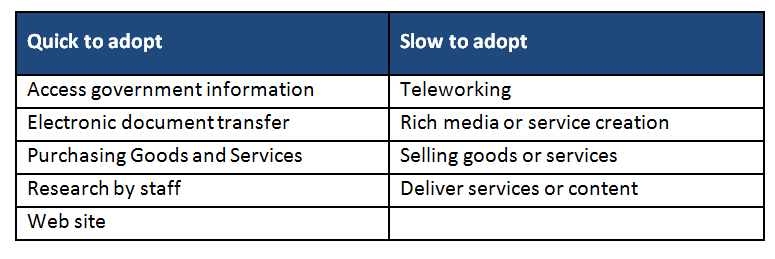SNG and its partners in Illinois are employing our industry-leading broadband utilization survey to build a foundation of understanding, from which we will develop broadband infrastructure planning and programs. Good data is at the heart of all good decision-making and planning as it provides insights for all that’s required to truly leverage broadband as a transformative regional initiative.
![]() It speaks to just how important Illinois sees broadband expansion and upgrades as part of their future that Illinois Lt. Governor Sheila Simon has taken a leadership position with the survey project recently deployed by Broadband Illinois/Partnership for a Connected Illinois. Drawing on SNG’s vast store of knowledge already acquired through similar work across the U.S., a team comprised of members of state agencies, universities, and SNG has been assembled. This team is undertaking an outreach communications program which has identified thousands of community organizations statewide and engaged dozens of Community Anchor Institutions to help “get the word out.”
It speaks to just how important Illinois sees broadband expansion and upgrades as part of their future that Illinois Lt. Governor Sheila Simon has taken a leadership position with the survey project recently deployed by Broadband Illinois/Partnership for a Connected Illinois. Drawing on SNG’s vast store of knowledge already acquired through similar work across the U.S., a team comprised of members of state agencies, universities, and SNG has been assembled. This team is undertaking an outreach communications program which has identified thousands of community organizations statewide and engaged dozens of Community Anchor Institutions to help “get the word out.”
Thousands of households and organizations have already submitted their responses. Broadband Illinois is so enthusiastic about the potential engendered by the household and organizations data they’ve extended response time and expanded sponsorship of participation to several other state agencies.
It’s thanks to these extensive efforts that participation rates are on the rise.
Even a Tech Firm Finds it Hard to Drive e-Solutions
by Doug Adams
The other day I was speaking with a colleague who is the Director of Marketing for a Tech Firm. This is a company filled with what most would consider “early adopters” and tech enthusiasts. In other words, a group of individuals who embrace broadband and e-solutions every day, in a myriad of ways.
 She was struggling with a decision of when to roll out a new e-solution to her sales team. It’s an online database/prospecting tool that provides invaluable information about the company’s prospects. She knows it is a great investment… a tool that will help her sales team grow their individual account base – and drive corporate sales… but, she is hesitant.
She was struggling with a decision of when to roll out a new e-solution to her sales team. It’s an online database/prospecting tool that provides invaluable information about the company’s prospects. She knows it is a great investment… a tool that will help her sales team grow their individual account base – and drive corporate sales… but, she is hesitant.
You see, my colleague is a pragmatist. While her company is a tech firm, sales people are notoriously tech laggards… and very slow to change their routine. Getting them to change or adopt new behaviors can be tough, and right now she’s fighting the uphill battle of getting them all connected – and using – a new CRM program.
So she’s resisting the internal pressure (and the pressure from her friendly sales person) to adopt this technology right now because, in her words, “I only get one chance to launch this, and I need to get it right… otherwise no one will use it.”
Whether she realizes it or not, she’s preaching the SNG story – adoption is great… utilization is what really matters.
And so she has a plan to come as close as she can to ensuring success. She will roll out this new solution after CRM has been adopted. She will provide this prospecting tool in a month where sales opportunities are down and sales people are more open to creative ways to find opportunities. And she will assign a few champions on the sales team to communicate the benefits and convey success stories.
While regions and communities chase expanding broadband availability and bridging the digital divide, we could learn a lot from my friend… make sure you have a strategy to drive utilization. Change can be seen as scary and daunting… line up the pieces and players in a manner that is most likely to produce utilization. SNG can help. Find out how we can provide you with that plan, a roadmap for each organization in your region, and champions to show the way to realize broadband’s transformative economic impacts.
by John de Ridder
 In the never ending quest for the “killer apps” that drive the uptake of broadband, one that we seem to have overlooked is digitization – which I’d call the ‘killer enabler’ of applications that undermines traditional carrier and regulatory models.
In the never ending quest for the “killer apps” that drive the uptake of broadband, one that we seem to have overlooked is digitization – which I’d call the ‘killer enabler’ of applications that undermines traditional carrier and regulatory models.
The following are some key insights on how digitization has changed the rules of the telecommunications industry. The impact the roll-out of broadband networks has had on key stakeholders is detailed in my update of the regulatory tool-kit for infoDev and the International Telecommunication Union (ITU) [1].
Digitization
Networks used to be built vertically around specific applications (e.g. voice or PayTV) but digitization ‘de-layers’ networks so that content or applications are no longer network specific. Next Generation Networks can support all applications over a single all-IP data network.
As data protocols are application agnostic, they create a problem for traditional operator business models which use applications and content services (e.g. calls) to subsidise carriage (i.e. the line rental or mobile handset). Digitization separates carriage and content services allowing ‘over-the-top’ (OTT) content and application services (e.g. Skype and Netflix).
Broadband
As policy makers and regulators focus on getting more broadband, there has been a shift in access policy. Traditionally, the focus has been on opening legacy copper networks to competition from new entrants. Unsurprisingly, incumbents complained that cost-based access-pricing was too low. They claimed this made them reluctant to invest in fibre access networks to improve broadband services. That made it a policy issue.
There is no clear best practice yet. It is too early to say which approaches work best and how country-specific circumstances might affect outcomes. Some countries have allowed ‘regulatory holidays’ so that the terms of access are determined commercially (e.g. USA). Many countries are determined to see ‘open access’ carried forward from copper to fibre networks; especially when they are supported by public investment.
Open access on fibre does not allow the same unbundling options that are available on copper networks (e.g. full or partial line-sharing). With the few exceptions where point-to-point fibre is deployed, the most common form of access will be bitstream.
Broadband networks displace switched interconnection with IP interconnection which makes the regulator’s task lighter because the access bottle-neck is removed.
Access Pricing
Access pricing for fibre based fixed access networks poses a dilemma for regulators. If they apply traditional cost based approaches to the large investments made in pushing fibre deeper into access networks, regulated prices will hinder the migration of customers from existing copper-based networks, which are largely written-down. Again, there is no clear best-practice on how to adapt existing costing methods and manage the transition.
Of course, with digitization service providers can go ‘over the top’ to deliver content and services to end customers. IP interconnection will be sufficient [2].
IP interconnection has existed in the internet system for many years with no regulation of ‘peering and transit’ arrangements. Many of these are similar to the ‘bill and keep’ (also known as ‘sender-keeps-all’) arrangements that apply to Receiving Party Network Pays mobile regimes; so for RPNP the transition is simple. For the more common situation in mobile and fixed networks, the transition is helped where termination rates are low. Again, the regulator’s task should become easier; once transitional issues are resolved.
The switched PSTN model is dying and there is divergence in regulatory approaches to the emerging world of next generation networks. Many regulators (rightly) hesitate to act too swiftly as whatever they do will shape the market. Operators of broadband networks will have to move swiftly to shift their business models towards charging for traffic.
End Notes
[1] Digitization is a key theme in the update of Module 2 (Competition and Pricing) of the infoDev/ITU tool kit for regulators at http://www.infodev.org/en/Publication.1140.html
[2] Control of the access line was important when carriage and content were joint in supply and demand; but with de-layering any provider can supply content and application services. However, bitstream access may confer a quality advantage in delivering managed services (e.g. IPTV) relative to over-the-top ‘best efforts’ content and applications (e.g. internet television).
It’s Fibre, Not Fiber at the European FTTH
Why Video is Not a Killer App
More than 3,300 interested in broadband flocked to Munich earlier this month to review the latest trends and best practices in our industry. We were thrilled to be able to participate and share our insights on broadband, its meaningful use, and how to maximize its benefits.
Chris Holden, the organization’s president, set a tone for the conference that aligned with SNG’s own mantra – the importance of meaningful use. Holden explained that the biggest challenge facing the FTTH (fiber) market is adoption and use… driving meaningful use. Holden explained that there seems to be an understanding gap when getting  people to switch.
people to switch.
The current hope is that video becomes the killer app that will drive more people to make the switch to fiber and therefore reap the untold benefits of faster Internet. Maybe. I may be a little less optimistic than the rest that video is a silver bullet. As a broadband evangelist, I realize the message must change to get the masses to “convert.” How does video matter to businesses operations and competitiveness? The fact is that there are lots of audiences for whom video does not currently matter. The real question is how can you make it relevant to them and personalize the context? For example, for health care providers and their patients, broadband video would become relevant with the availability of telemedicine.
There are no shortcuts, no killer apps, or silver bullets. It’s still Marketing 101 – tangible benefits are the only thing that moves move the needle.
Beyond the Killer App
There’s No Holy Grail, But There’s Utilization
by Michael Curri
Only through driving an understanding of the benefits of multiple e-solutions (enabled by broadband) can a community can truly create a platform for innovation. To clarify, when I talk about broadband I mean high-speed, reliable and affordable access to the Internet so that a business, organization or household can effectively participate in the digital economy.
Some people have the experience, or can figure out what fiber can mean for them – but many do not. They need to be shown and have the value of FTTH (fiber) be personalized to the needs of their business, organization, or household – it’s not self-evident to most people how, for example, to transform their operations and deliver their services or content online. And of course, many e-solutions are more complex and sophisticated in nature, making them slower to be adopted (or understood … or both). This issue needs to be understood and addressed by providers of FTTH.
The table below shows rankings based on adoption rates for organizations with average utilization levels equal to a Digital Economy index (DEi) score of 6. As a reminder, DEi is a proprietary SNG measure where scores range from 1 to 10 (10 being highest). The higher scores reflecting the greater the number, scope and sophistication of the Internet activities deployed in an organization.
e-Solutions Adoption Rates for “Average” Organizations (with DEi of 6)

Those with lower utilization adopt the easier to use applications first while more sophisticated and difficult applications tend to be adopted later, especially by organizations that already have high utilization.
What does it mean to have a high capacity, high quality, reliable and affordable Internet? It depends on who the end-user is (by industry sector), what they’re currently doing (i.e. their business operations), what they want to be doing, and what they should be doing to remain competitive
Until the FTTH vendors figure out how to personalize the value of FTTH to end-users, adoption and meaningful use will continue to be an issue – and they won’t be seeing the uptake by end-users that can justify their investment in FTTH networks.
This is where the business case and the economic case for investing in FTTH needs to be looked at from an economic perspective. SNG presented on impacts from broadband and FTTH from SNG findings and I then turned to how that information could be used to drive economic development through broadband. I encourage you to review the material covered at the conference by clicking here.
News from the Field: Kentucky
In Kentucky, the process of outreach is underway. Led by the Office of Broadband Outreach in Frankfort, KY, SNG and their partners have deployed broadband utilization surveys statewide directly to over 120,000 residential and organizations email addresses. As in Illinois the survey is open to the public and available on the host agency websites.
Where in some instances, survey participation is seen in “pockets” of activity, surveys have been received from every corner and county in Kentucky. This is particularly important in the more mountainous Appalachian areas of South and Eastern Kentucky where, historically, broadband capacity and availability has been lacking.
Kentucky sees a high rate of interest from radio and print media which has provided a nice little push encouraging survey completion.
There’s No Holy Grail, But There’s Utilization
by Michael Curri
Only through driving an understanding of the benefits of multiple e-solutions (enabled by broadband) can a community can truly create a platform for innovation. To clarify, when I talk about broadband I mean high-speed, reliable and affordable access to the Internet so that a business, organization or household can effectively participate in the digital economy.
Some people have the experience, or can figure out what fiber can mean for them – but many do not. They need to be shown and have the value of FTTH (fiber) be personalized to the needs of their business, organization, or household – it’s not self-evident to most people how, for example, to transform their operations and deliver their services or content online. And of course, many e-solutions are more complex and sophisticated in nature, making them slower to be adopted (or understood … or both). This issue needs to be understood and addressed by providers of FTTH.
The table below shows rankings based on adoption rates for organizations with average utilization levels equal to a Digital Economy index (DEi) score of 6. As a reminder, DEi is a proprietary SNG measure where scores range from 1 to 10 (10 being highest). The higher scores reflecting the greater the number, scope and sophistication of the Internet activities deployed in an organization.
e-Solutions Adoption Rates for “Average” Organizations (with DEi of 6)

Those with lower utilization adopt the easier to use applications first while more sophisticated and difficult applications tend to be adopted later, especially by organizations that already have high utilization.
What does it mean to have a high capacity, high quality, reliable and affordable Internet? It depends on who the end-user is (by industry sector), what they’re currently doing (i.e. their business operations), what they want to be doing, and what they should be doing to remain competitive
Until the FTTH vendors figure out how to personalize the value of FTTH to end-users, adoption and meaningful use will continue to be an issue – and they won’t be seeing the uptake by end-users that can justify their investment in FTTH networks.
This is where the business case and the economic case for investing in FTTH needs to be looked at from an economic perspective. SNG presented on impacts from broadband and FTTH from SNG findings and I then turned to how that information could be used to drive economic development through broadband. I encourage you to review the material covered at the conference by clicking here.
Why Video is Not a Killer App
More than 3,300 interested in broadband flocked to Munich earlier this month to review the latest trends and best practices in our industry. We were thrilled to be able to participate and share our insights on broadband, its meaningful use, and how to maximize its benefits.
Chris Holden, the organization’s president, set a tone for the conference that aligned with SNG’s own mantra – the importance of meaningful use. Holden explained that the biggest challenge facing the FTTH (fiber) market is adoption and use… driving meaningful use. Holden explained that there seems to be an understanding gap when getting  people to switch.
people to switch.
The current hope is that video becomes the killer app that will drive more people to make the switch to fiber and therefore reap the untold benefits of faster Internet. Maybe. I may be a little less optimistic than the rest that video is a silver bullet. As a broadband evangelist, I realize the message must change to get the masses to “convert.” How does video matter to businesses operations and competitiveness? The fact is that there are lots of audiences for whom video does not currently matter. The real question is how can you make it relevant to them and personalize the context? For example, for health care providers and their patients, broadband video would become relevant with the availability of telemedicine.
There are no shortcuts, no killer apps, or silver bullets. It’s still Marketing 101 – tangible benefits are the only thing that moves move the needle.
In Kentucky, the process of outreach is underway. Led by the Office of Broadband Outreach in Frankfort, KY, SNG and their partners have deployed broadband utilization surveys statewide directly to over 120,000 residential and organizations email addresses. As in Illinois the survey is open to the public and available on the host agency websites.
Where in some instances, survey participation is seen in “pockets” of activity, surveys have been received from every corner and county in Kentucky. This is particularly important in the more mountainous Appalachian areas of South and Eastern Kentucky where, historically, broadband capacity and availability has been lacking.
Kentucky sees a high rate of interest from radio and print media which has provided a nice little push encouraging survey completion.
 The Nunavut Broadband Development Corporation (NBDC) in Canada’s Arctic recently engaged SNG to measure the impacts-to-date of broadband investments and to forecast broadband needs and investment levels required to meet those needs.
The Nunavut Broadband Development Corporation (NBDC) in Canada’s Arctic recently engaged SNG to measure the impacts-to-date of broadband investments and to forecast broadband needs and investment levels required to meet those needs.
NBDC is a not-for-profit, federally registered corporation with a membership representing community, private sector and citizen interests. This project is made possible with funding support from CanNor.

SNG Selected by Two North American Regions to Drive Broadband’s Benefits
Greetings and Happy New Year from each and every one of us at SNG in our offices across the globe, from North America, to Europe, to Australia. Already we’ve hit the ground running in what’s sure to be a big year from Broadband with stimulus hitting its stride, from America to Australia. We look forward to providing you with our latest findings in the coming months.
First, we wanted to provide you with what we hope to be something to get you inspired as we share about our two latest projects. Is your region taking a serious step towards driving a 21st century economy, or are you just building networks? If the answer is the former, you’d fit in nicely with our two latest clients. And we’d love to lend our expertise.
Illinois and SNG Announce Partnership
Partnership for a Connected Illinois Announces Partnership with Strategic Networks Group to Drive Meaningful Broadband Use, Innovation, and Economic Development
SNG and the Illinois Institute of Rural Affairs Engaged to help Maximize Broadband’s Potential
SPRINGFIELD, Illinois, January 4, 2012 – The Partnership for a Connected Illinois , also known through its Broadband Illinois website, today announced further efforts to utilize broadband for driving better learning tools for school children, growing the Sta  te’s job base, driving innovation and increasing economic prosperity, and improving health care.
te’s job base, driving innovation and increasing economic prosperity, and improving health care.
PCI will work in a partnership with Strategic Networks Group (SNG) and the Illinois Institute of Rural Affairs in order to maximize the benefit of public and private-sector investments in broadband deployment and use. These investments have the potential to be a transformative investment for Illinois’ 21st century competitiveness.
The PCI initiative includes a state broadband strategy, informed by statewide research to measure broadband’s utilization and identify gaps. The result will be a statewide broadband plan preparing Illinois to be a leader in job creation and economic growth, education, medical innovation and quality of life. Another output of the research will be reports to individual organizations to help them understand how they can become more competitive through broadband.
“By developing a statewide broadband strategy for better broadband, we’re creating a future that includes economic opportunities, increased availability of educational tools, and higher-quality health care for Illinois residents,” said Drew Clark, executive director of PCI. “Better broadband means better lives. Our mission is to make high-speed broadband internet available to residents throughout Illinois.”
In developing a statewide broadband plan, the Partnership for a Connected Illinois is conducting statewide research on behalf of the State of Illinois in order to develop strategies that will position Illinois to be a leader in job creation and economic growth, education, medical innovation and quality of life.
Illinois turned to SNG due to their proven track record with maximizing broadband investment in more than 10 states, and in other regions throughout the world. The solutions that SNG brings to bear will help Illinois ensure that its broadband investment has deep, meaningful, and lasting impacts.
Partnering with SNG in support of this initiative is the Illinois Institute for Rural Affairs of Western Illinois University, which will help provide a statewide approach to accelerate the understanding and meaningful use of broadband for global competitiveness, job creation, and socio-economic impacts.
“Forward-looking governments understand the direct benefits that broadband and e-solutions bring, including increasing competitiveness, productivity, and revenues,” explains Michael Curri, president of SNG. “We’re delighted that Illinois is embracing the process of turning broadband’s potential into a strategy to create jobs, retain and attract businesses, and improve the overall quality of life of its citizens.”
About Partnership for a Connected Illinois (PCI)
PCI, also known for its Broadband Illinois website, is a non-profit entity working on behalf of the State of Illinois. PCI collects data about broadband availability and works with local providers and communities to make high-speed broadband available throughout the state. PCI is also working to improve the adoption and enhance the impact of broadband in Illinois. Learn more about PCI at broadbandillinois.org.
About Strategic Networks Group
SNG is a group of broadband economists who develop strategies for most effectively leveraging broadband investments. SNG looks to help make the most broad-reaching and transformational impacts that broadband can bring enable businesses, communities and regions by delivering the data and analysis decision makers need to maximize broadband’s potential. SNG’s goals: economic development, social advancement, increased productivity and competiveness. Learn more about SNG online at www.sngroup.com and discover how broadband market analytics can accelerate regional economic development.
About the Illinois Institute for Rural Affairs
IIRA is a unit of Western Illinois University and has served the people of rural Illinois since 1989. Its mission is “to improve the quality of life for rural residents by partnering with public and private agencies on local development and enhancement efforts.” The IIRA’s 40-member staff delivers on its mission through its research and outreach efforts.
Click to see this announcement on PCI’s website.
SNG Hard at Work in Canada’s Arctic
 The Nunavut Broadband Development Corporation (NBDC) in Canada’s Arctic recently engaged SNG to measure the impacts-to-date of broadband investments and to forecast broadband needs and investment levels required to meet those needs.
The Nunavut Broadband Development Corporation (NBDC) in Canada’s Arctic recently engaged SNG to measure the impacts-to-date of broadband investments and to forecast broadband needs and investment levels required to meet those needs.
NBDC is a not-for-profit, federally registered corporation with a membership representing community, private sector and citizen interests. This project is made possible with funding support from CanNor.
Over the next few months, SNG will conduct an assessment of the socioeconomic impact of broadband in Nunavut, which will:
- Establish and implement a framework to provide an assessment of the socioeconomic impact of broadband in Nunavut for to the Nunavut Broadband Development Corporation

- Measure the benefits of broadband in monetary and qualitative terms as they relate to regional businesses, residential customers, communities, and nongovernmental organizations
- Show both the economic and social impacts of broadband
- Forecast future demand for Broadband in Nunavut
- Present three investment scenarios for broadband in Nunavut, including the socioeconomic costs and benefits of each scenario
We’re excited to help this area of Canada harness the power of broadband. Stay tuned in 2012 for our findings and how broadband can impact even the most sparsely populated regions.
Fibre to the Home Council Europe
 Attending the Fibre to the Home Conference in Munich February 15th and 16th? If so, make sure to stop by to say “Hi” to Michael Curri and take in his presentation at 14:30 on the 15th, Socio-economic Benefits of FTTH Networks.
Attending the Fibre to the Home Conference in Munich February 15th and 16th? If so, make sure to stop by to say “Hi” to Michael Curri and take in his presentation at 14:30 on the 15th, Socio-economic Benefits of FTTH Networks.
Learn More About the Conference>>
